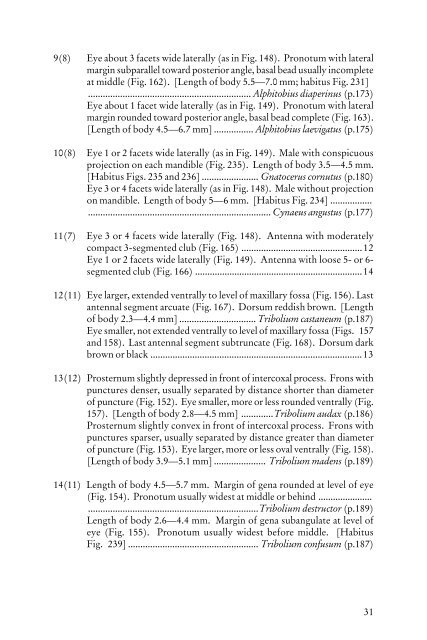Beetles Identification Guide
Beetles Identification Guide
Beetles Identification Guide
Create successful ePaper yourself
Turn your PDF publications into a flip-book with our unique Google optimized e-Paper software.
9(8) Eye about 3 facets wide laterally (as in Fig. 148). Pronotum with lateral<br />
margin subparallel toward posterior angle, basal bead usually incomplete<br />
at middle (Fig. 162). [Length of body 5.5—7.0 mm; habitus Fig. 231]<br />
.................................................................. Alphitobius diaperinus (p.173)<br />
Eye about 1 facet wide laterally (as in Fig. 149). Pronotum with lateral<br />
margin rounded toward posterior angle, basal bead complete (Fig. 163).<br />
[Length of body 4.5—6.7 mm] ................ Alphitobius laevigatus (p.175)<br />
10(8) Eye 1 or 2 facets wide laterally (as in Fig. 149). Male with conspicuous<br />
projection on each mandible (Fig. 235). Length of body 3.5—4.5 mm.<br />
[Habitus Figs. 235 and 236] ....................... Gnatocerus cornutus (p.180)<br />
Eye 3 or 4 facets wide laterally (as in Fig. 148). Male without projection<br />
on mandible. Length of body 5—6 mm. [Habitus Fig. 234] .................<br />
.......................................................................... Cynaeus angustus (p.177)<br />
11(7) Eye 3 or 4 facets wide laterally (Fig. 148). Antenna with moderately<br />
compact 3-segmented club (Fig. 165) .................................................12<br />
Eye 1 or 2 facets wide laterally (Fig. 149). Antenna with loose 5- or 6segmented<br />
club (Fig. 166) ....................................................................14<br />
12(11) Eye larger, extended ventrally to level of maxillary fossa (Fig. 156). Last<br />
antennal segment arcuate (Fig. 167). Dorsum reddish brown. [Length<br />
of body 2.3—4.4 mm] ............................... Tribolium castaneum (p.187)<br />
Eye smaller, not extended ventrally to level of maxillary fossa (Figs. 157<br />
and 158). Last antennal segment subtruncate (Fig. 168). Dorsum dark<br />
brown or black ......................................................................................13<br />
13(12) Prosternum slightly depressed in front of intercoxal process. Frons with<br />
punctures denser, usually separated by distance shorter than diameter<br />
of puncture (Fig. 152). Eye smaller, more or less rounded ventrally (Fig.<br />
157). [Length of body 2.8—4.5 mm] .............Tribolium audax (p.186)<br />
Prosternum slightly convex in front of intercoxal process. Frons with<br />
punctures sparser, usually separated by distance greater than diameter<br />
of puncture (Fig. 153). Eye larger, more or less oval ventrally (Fig. 158).<br />
[Length of body 3.9—5.1 mm] ..................... Tribolium madens (p.189)<br />
14(11) Length of body 4.5—5.7 mm. Margin of gena rounded at level of eye<br />
(Fig. 154). Pronotum usually widest at middle or behind ......................<br />
.....................................................................Tribolium destructor (p.189)<br />
Length of body 2.6—4.4 mm. Margin of gena subangulate at level of<br />
eye (Fig. 155). Pronotum usually widest before middle. [Habitus<br />
Fig. 239] ..................................................... Tribolium confusum (p.187)<br />
31
















